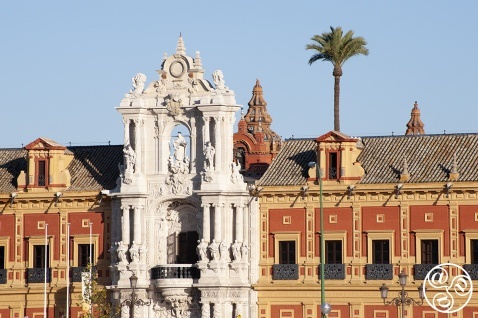
Palacio San Telmo |
|
Palacio San Telmo
This magnificent palace is one of Seville's most impressive buildings, and certainly the city's finest example of the baroque style. Situated to the south of the centre, between the Hotel Alfonso XIII and the river, its 40-million-euro, 10-year refurbishment finished in 2010. The palace is the seat of the Regional Government's President.
What is it?
Palacio San Telmo was built in 1682 to serve as a marine academy, training ships' pilots, navigators and high-ranking officers - it is named after San Telmo (Saint Elmo), the patron saint of navigators. The academy then became a royal palace, whose private estate stretched as far as the Parque Maria Luisa, and after that a seminary and a hospital. The palace fell into disrepair in the mid-20th century, but was refurbished in the 1980s and today is the presidential headquarters of the Junta de Andalucia (the regional government). The Junta President received the Duke and Duchess of Cornwall here on their visit to Seville in April 2011.
The palace's main feature is the exuberant stone Churrigueresque portal on the main façade, overlooking Avenida de Roma and the Jardines del Cristina. This was built by three generations of the Figueroa family, as it took over 70 years to complete. Surrounding the columns you can see female allegorical figures representing the arts and sciences. San Telmo is holding a ship and charts, flanked by the sword-bearing San Fernando (patron saint of Seville, whose statue you can also see in Plaza Nueva) and San Hermenegildo (who was martyred in Seville) with a cross.
This massive building, painted in distinctive red and dark yellow, covers an entire city block. It faces Avenida de Roma, and its walled gardens stretch back along the Paseo de las Delicias, which runs parallel to the river, as far as Calle de la Rabida.
What was it used for?
Palacio San Telmo was originally built as the Colegio Seminario de la Universidad de Mareantes, a home for orphaned children of sailors. Then it was used to train those who sailed the ships of the Flota de las Indias, the Indies Fleet. These vessels brought back the riches from Spain's New World colonies, thereby building up Seville's wealth, and global power and influence.
From 1847 it was the headquarters of the Railway Society, and the site of the Literary University, but upkeep made it prohibitively expensive.
In 1849, the building was bought by a rich patron, Antoine d'Orleans, Duke of Montpensier, and his wife Infanta Maria Luisa Fernanda de Bourbon, daughter of King Fernando VII and sister of Queen Isabel II (her daughter Maria Isabel married King Alfonso XII). The Dukes converted San Telmo into a royal palace, with appropriately luxurious furniture and decoration for a seat of the Bourbon family; they added the Salon de Espejos (see below) as a ballroom. It was Maria Luisa who donated a large part of the palace's extensive private grounds to the city of Seville in 1893, which became the Parque Maria Luisa, the site of the 1929 Expo. When she died, the Infanta bequeathed the palace to the Archdiocese of Seville.
In 1901 the palace became a seminary again, this time for priests, also taking in wounded soldiers during the war with Morocco. It underwent several structural changes, which damaged the design and proportions. In 1952 it was badly damaged by a fire, and was neglected for years, until it was taken over by the Junta in 1989.
What can I see there?
Main points to look out for: the Patio de San Jeronimo behind the entrance, with clock tower, palm trees and small busts of Seville's most famous historic figures all around the wall, such as San Leandro and Santa Justa; the chapel (see below); the Salon de Espejos, both the interior and the outside view, where the tour starts; and the mural of tiles, a dazzling geometric display of local azulejos on a staircase which leads down from the ground floor to the basement. Also, don't miss the statues along the side wall (on calle Palos de la Frontera) of the palace.
The chapel, which dates from 1721, is full-on baroque, with every scroll, curl and cherub of its altar coated in gilt Its centrepiece is the Virgen del Buen Aire, protector of sailors, and also features various statues, paintings and reliefs.
The Salon de Espejos (Room of Mirrors), built originally as a ballroom in the palace's royal days, is now used for receptions - you'll see it as a backdrop in photos of visiting dignitaries. It was built onto the side of the palace, with one long wall of arched lead-paned windows offering views of the gardens, and an intricately painted ceiling. Its elegant simplicity serves as a welcome contrast to the extravagant gilted baroque of the chapel.
The upstairs rooms have parquet floors and inlaid and painted coffered wood ceilings. This is where the Junta President's office is located, at the far end on the left - at the corner of the building overlooking Puerta de Jerez.
On the side of the palace on Calle Palos de la Frontera, facing the Hotel Alfonso XIII, are 12 statues of illustrious Sevillanos, the most famous of whom are Rodrigo Ponce de Leon, Duke of Arcos (an adoptive Sevillano); writer Lope de Rueda; painters Velazquez and Murillo; Miguel Mañara, founder of the Hospital de La Caridad; and Fray Bartolome de las Casas, a Dominican bishop who campaigned against mistreatment of slaves - an early human rights activist.
When can I visit?
Palacio San Telmo is open to visitors by guided tour only; call to check days and times, and make an appointment. Tel: 955 001 010 Registration page (Spanish)
Unfortunately the grounds aren't open to the public yet, although these are also being restored to their former glory.
Avenida de Roma S/N